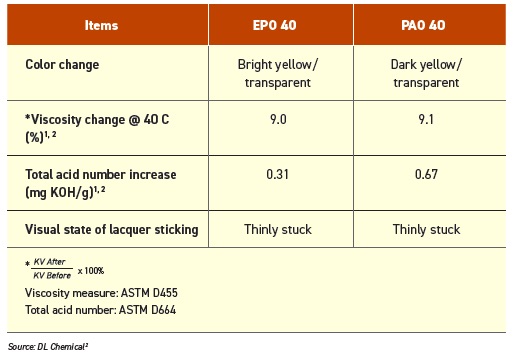KEY CONCEPTS
•
Mineral oils can be good general lubricants but have viscosity and temperature limitations as well as limited biodegradability.
•
Synthetic base oils are designed to be superior to mineral base oils through better low-temperature performance, oxidation stability, viscosity index and extended life.
•
Ethylene-propylene oligomer (EPO) is a new synthetic base oil that can be used as both a base oil and as a viscosity modifier.
Synthetic base oils are created using scientifically designed molecules that mimic the best hydrocarbon structure found in mineral oils. The goal is for synthetic base oils to be superior to mineral base oils by offering better low-temperature performance, better oxidation stability, better viscosity index and extended life.
As equipment technology improves, the demand for lubricant base oils that can meet more demanding equipment conditions also increases. This demand for these synthetic base oils is increasing each year for special applications, including for industrial gear oil, hydraulic and grease applications. Ethylene-propylene oligomer (EPO) is one synthetic base oil that can act as either a base oil or as a viscosity modifier.
Issues with currently available base oils
Mineral base oils are refined versions of crude petroleum oil from the ground. These oils tend to be relatively inexpensive lubricants but have viscosity and temperature limitations (i.e., thin at high temperatures, thick at low temperatures) and limited biodegradability.
Synthetic base oils are manufactured materials that are intended to have better properties than mineral oils. A common synthetic base oil is polyalphaolefin (PAO); however, PAO has supply limitations caused by a lack of the raw material (i.e., linear alphaolefin). A nonpolar liquid, PAO’s strengths include a high viscosity index, high thermal and oxidative stability, low volatility and good flow properties at low temperatures, while also being non-toxic. However, PAO also offers a limited viscosity range, limited biodegradability and the risk of seal incompatibility.
These issues make finding another source of synthetic base oils with a wider viscosity range and better properties important.
Ethylene-propylene oligomer
STLE member Dr. Dianta Ginting, researcher with DL Chemical in Daejeon, South Korea, explains, “EPO is a metallocene-based synthetic oil containing ethylene and propylene oligomer.” He states, “Metallocene-based catalysts are one of the most important developments in polymer technology following the discovery of heterogeneous olefin Ziegler-Natta catalysts.
1 It is possible to control EPO’s physical and electrical properties and to create uniform homo- and co-polymers with narrow molecular weight distributions because of their single-site property.”
Advantages of EPO
Ginting identifies the advantages of products made using metallocene-based catalysts as having “excellent thickening property and shear stability, good low temperature property, good oxidation stability and good appearance.” The advantages of metallocene catalysts products are high activity, wide product range, narrow and uniform molecular weight distribution, good physical performance and good electrical properties.
The EPO can be an alternative for either a viscosity modifier or a heavy synthetic base oil. Ginting identifies several advantages that EPO offers, including the following:
•
good fluidity at low temperatures
•
good thickening and excellent shear stability when used as a viscosity modifier
•
good chemical stability
•
good oxidation stability
•
high viscosity index
•
non-toxic
•
easy to handle
•
low friction coefficient.
Synthetic base stocks have varying properties such as molecular structure (e.g., saturated, molecular weight distribution, atactic structures, etc.). When EPO and PAO properties are compared in Table 1, the two fluids are shown to be similar, although EPO has better oxidation stability. In addition, the raw material used to manufacture EPO is more available than the raw materials needed to manufacture PAO, making EPO more economical.
 Table 1. Oxidation and corrosion stability test (163 C, 72 hours, Cu-Fe)
Table 1. Oxidation and corrosion stability test (163 C, 72 hours, Cu-Fe)
STLE member Dr. Shubhamita Basu is the North American product manager with the Lubrizol Corp. in Wickliffe, Ohio. She explains that EPOs can be used as either a base oil or as a viscosity modifier due to their various molecular weights, chain types and chain lengths. Basu says, “Lower molecular weight EPOs can serve as a synthetic base oil, while the higher molecular weight EPOs can act both as base oils and as viscosity modifiers.” Basu also notes, “Specially designed EPOs are capable of reducing the traction coefficient and energy consumption, in addition to offering increased shear stability and a wider operating temperature window.”
Basu concurs with Ginting that EPOs have a number of advantages compared to other synthetic base oils. Basu lists those advantages as including that “the EPO class of synthetic base oils are highly pure and offer a low traction coefficient, high shear stability and high thermal and oxidative stability.” However, Basu says, similar to “their PAO counterparts, EPOs tend to be of low polarity due to their high levels of saturation and may need a co-solvent” to be effective.
Basu identifies that EPOs are appropriate “in any lubricant applications where synthetic base oils (like PAOs) are preferred. Higher molecular weight EPOs (used primarily as viscosity modifiers) can have extensive applications in both mineral and synthetic formulations, including automotive and industrial gear oils, hydraulic fluids, greases and open gear lubricants, among other things. EPOs also can be used as viscosity modifiers in applications like engine oils where olefin copolymers are typically used.”
Stephanus Andhy Christian is a product development engineer with P.T. Alp Petro Industry in Indonesia. Christian identifies the advantages of synthetic base oils as being “more heat resistant, having a lower pour point than a mineral oil base, having a more stable viscosity, having a higher viscosity index and being more resistant to oxidation.” These advantages allow for a longer service life. Christian notes that disadvantages of EPOs compared to mineral oils include being “more expensive, having a higher evaporation loss for a lower viscosity and being less economical for lubricant applications in old machines technology (i.e., monograde-type lubricants).”
 Supply and demand
Supply and demand
Christian expects that “in countries such as Indonesia or Asia, where machines with old technology are still widely used for both automotive and industrial use, mineral lubricants such as monograde lubricants (i.e., SAE 40, SAE 50, ISO VG 150, ISO VG 220, ISO VG 460)” will remain in demand. This means that mineral oil is still needed, even though some applications could replace it with synthetic oil. Price considerations also are still a concern for many industries, even taking into account the advantages of existing synthetic oil technology.
Regarding the demand for synthetic base oil for the next five years, Christian expects the industry to eventually offer “prices that are more acceptable to customers (i.e., not more expensive than mineral oil).” He notes, “Synthetic base oil technology can be used as a substitute for mineral oil, especially for viscous base oil grades (i.e., SN 600, BS 150).”
In Indonesia, Christian notes, “PAO and EPO synthetic oils are still very rarely used because of the high price.”
Conclusion
EPO is a synthetic base oil or viscosity modifier that can be a successful alternative to mineral oil, depending on the application and other considerations such as cost.
REFERENCES
1.
Shamiri, A., Chakrabarti, M. H., Jahan, S., Hussain, M. A., Kaminsky, W., Aravind, P. V. and Yehye, W. A. (2014), “The influence of Ziegler-Natta and metallocene catalysts on polyolefin structure, properties, and processing ability,”
Materials, 7 (7), pp. 5069-5108, click
here.
2.
FINA research process for producing liquid ethylene-type random copolymers (1992), EP 0 586 777 B1. 31. 08.
Andrea R. Aikin is a freelance science writer and editor based in the Denver area. You can contact her at pivoaiki@sprynet.com.